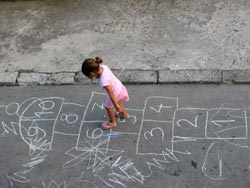The age from when children can hop on one leg

At the age of five children can hop on one leg.<br>picture: © Vladislav Gajic - Fotolia.com<br>
Together with colleagues from Lausanne, researchers from the University Children’s Hospital Zurich and the University of Zurich have determined normative data for different exercises such as hopping or running. This enables parents and experts to gage the motor skills of young children for the first time objectively and thus identify abnormalities at an early stage.
My child still can’t stand on one leg or walk down the stairs in alternating steps while all the other children already can. Are my child’s motor skills normal or does he need therapy? Parents of children of a pre-school age often ask questions like these and experts wonder from which age a child should really be able to perform certain motor tasks.
Until now, there has been a lack of reliable data that describes the age from which children are able to stand on one leg, hop on one leg, climb stairs or run. Such standards have been lacking as it was assumed that motor performance in children under the age of five could not be measured reliably. For children aged between five and eighteen, however, there is an instrument called the Zurich Motor Assessment created by Remo Largo and his team at the University Children’s Hospital Zurich in 2001. This test procedure is used by many experts to examine neuromotor skills in children of a school age.
New tests for young children
Neurophysiologist Tanja Kakebeeke and developmental pediatrician Oskar Jenni from the University Children’s Hospital Zurich have now extended this test, simplified it for pre-school children aged between three and five and collected normative data for this age group. The test contains gross and fine motor exercises and additional tasks where children are supposed to run, hop, climb stairs and balance.
The tests described in their study reveal that young pre-school children are not yet able to perform certain tasks such as hopping or standing on one leg for longer than two seconds. “Children develop these skills between the age of three and five but very quickly and they are able to at the age of five,” explains Kakebeeke.
At the age of three, only forty percent of the children were able to stand on one leg briefly. At five years of age, they all could. As soon as a child was able to do a task and his or her performance was measurable, it was classified on a five-point scale. The best performance, for example, was thus: The child can stand on one leg – the right and the left – for longer than five seconds. The normative data then developed from the proportion of children who can perform a skill and the actual performance of these children. With the normative data, motor development abnormalities can now be diagnosed at an early stage and therapeutic measures initiated.
Literature:
Tanja H. Kakebeeke, Jon Caflisch, Aziz Chaouch, Valentin Rousson, Remo H. Largo, Oskar G. Jenni. Neuromotor development in children. Part 3: motor performance in 3- to 5-year-olds. Developmental Medicine & Child Neurology. DOI: 10.1111/dmcn.12034
Contacts:
PD Dr. Tanja H. Kakebeeke
Child Development Center
University Children’s Hospital Zurich
Tel: +41 44 266 79 18
E-Mail: tanja.kakebeeke@kispi.uzh.ch
PD Dr. Oskar Jenni
Child Development Center
University Children’s Hospital Zurich
Tel. +41 44 266 77 51
E-Mail: oskar.jenni@kispi.uzh.ch
Media Contact
More Information:
http://www.uzh.chAll latest news from the category: Health and Medicine
This subject area encompasses research and studies in the field of human medicine.
Among the wide-ranging list of topics covered here are anesthesiology, anatomy, surgery, human genetics, hygiene and environmental medicine, internal medicine, neurology, pharmacology, physiology, urology and dental medicine.
Newest articles

Innovative 3D printed scaffolds offer new hope for bone healing
Researchers at the Institute for Bioengineering of Catalonia have developed novel 3D printed PLA-CaP scaffolds that promote blood vessel formation, ensuring better healing and regeneration of bone tissue. Bone is…

The surprising role of gut infection in Alzheimer’s disease
ASU- and Banner Alzheimer’s Institute-led study implicates link between a common virus and the disease, which travels from the gut to the brain and may be a target for antiviral…

Molecular gardening: New enzymes discovered for protein modification pruning
How deubiquitinases USP53 and USP54 cleave long polyubiquitin chains and how the former is linked to liver disease in children. Deubiquitinases (DUBs) are enzymes used by cells to trim protein…



